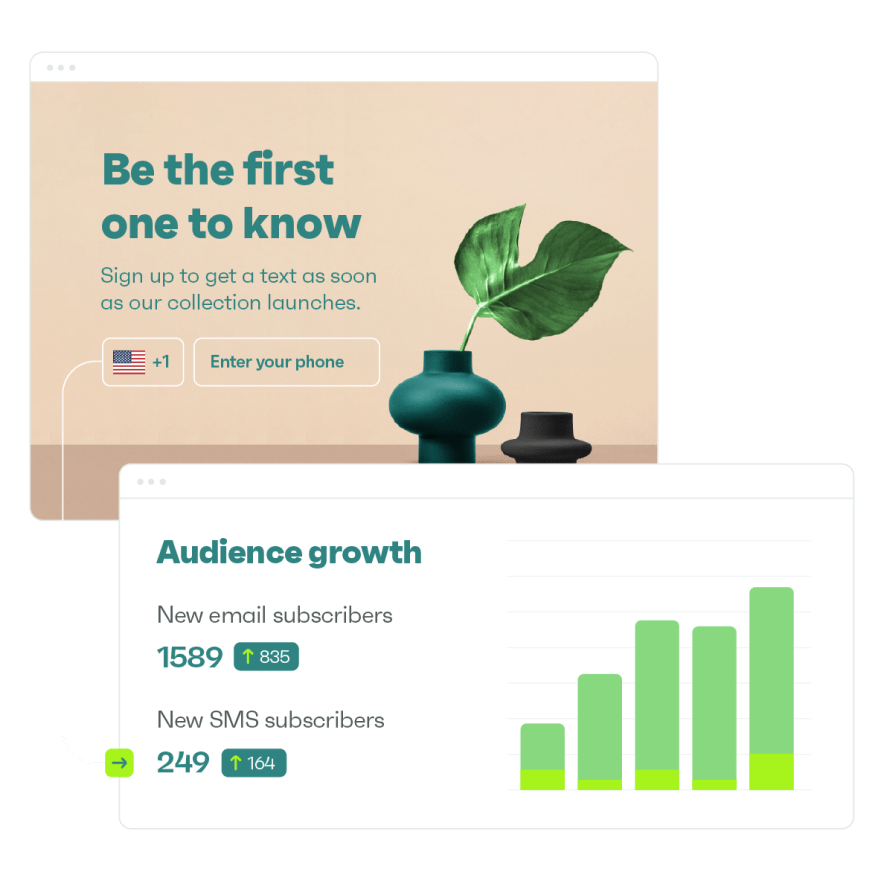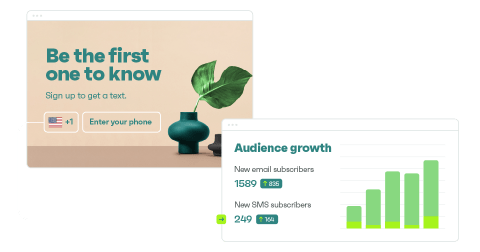Drive sales on autopilot with ecommerce-focused features
See FeaturesHow to start a t-shirt business in 2024: Tools & tips for success
A common myth about starting a t-shirt business is that creativity and a niche market are all you need.
The reality is that you need a lot more than that to sustain and grow your business. You need a solid plan, effective strategies, a clear roadmap, and the right tools.
That’s why we created this article, to help you learn how to start a t-shirt business in 2024.
We’ll share how to source quality materials, build your store, and market your brand. We’ll also give you tips on how to avoid common pitfalls and succeed in this competitive industry.
The rising popularity of t-shirt businesses
T-shirts are versatile, customizable, and affordable. This makes them appealing to a wide range of customers.
The rise of ecommerce platforms has also made starting a t-shirt business accessible. So has a growing demand for personalized clothing. Here’s why this is the case:
- Online marketplaces: T-shirt sellers have access to a wide range of ecommerce platforms. Websites like Etsy and Shopify enable entrepreneurs to showcase and sell designs globally.
- Social media amplification: Social media marketing amplifies the reach of t-shirt businesses. It fosters brand awareness and customer engagement.
- Friendly business models: These include dropshipping and print-on-demand services. They simplify inventory management and enable entrepreneurs to fulfill orders seamlessly. These business models reduce upfront costs.
With this in mind, it’s no wonder many view selling t-shirts online as one of the best side hustle ideas ever. If done right, selling t-shirts online can become a full-time career.
Next, let’s get into the specifics of how to start a t-shirt business.
Choosing your t-shirt business model
When starting a t-shirt business, you must decide your sales and production strategies. Create strategies that align with your business model. This is crucial for your t-shirt business success:. Iit impacts everything, from the required upfront investment to day-to-day operations.
If you’re wondering how to start a t-shirt business, you can adopt any of these approaches:
- Stocking inventory: This is ideal for those wanting to stock up and sell their t-shirts in bulk. Here, you buy t-shirts from a wholesaler, print or outsource the printing, and store them. This model requires a higher cash investment, increasing the risk, but can be the most flexible and profitable.
- Print-on-demand: This is ideal for those wanting to start small. This model reduces upfront costs as you only produce items when you receive an order. It’s perfect for selling custom t-shirts. You simply create and upload your designs to a platform that prints and ships the t-shirt for you.
- Dropshipping: This is also ideal for a flexible, lean startup. Like the print-on-demand approach, t-shirt entrepreneurs handle the marketing and sales. The difference is that entrepreneurs rely on the supplier’s existing inventory. They don’t customize the t-shirts.
Here’s a visual representation of the dropshipping model.
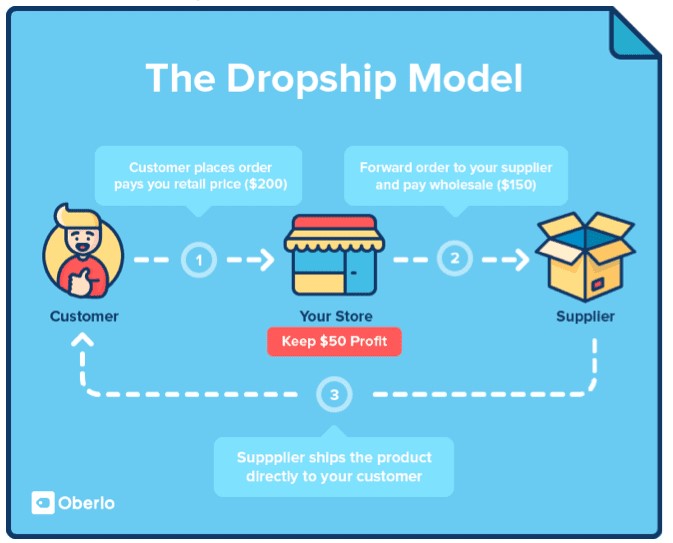
Identifying your target market and niche
The most essential step in starting a t-shirt business is identifying your customers. Know who they are and what interests them.
Here’s how to identify your customers.
Conduct market research
Researching how to start a t-shirt business from home, helps you identify competition and the gaps your brand could potentially fill. Follow these steps to conduct your market research:
- Identify your target audience: Determine the core demographics of potential customers. What are their ages, gender, location, interests, and purchasing habits?
- Analyze your competition: Research existing businesses for their strengths and weaknesses. This will help you differentiate your business and identify growth opportunities.
- Identify market trends: Follow successful Shopify clothing stores and other trendy businesses. Keeping up with the latest in fashion ensures continued relevance and appeal.
- Gather feedback: Use social media polls and focus groups to survey potential customers. This will help you understand their needs, pains, and preferences.
Define your unique selling proposition
Do you have a clear idea of who your target market is? If yes, it’s time to define what makes your business different and better than others. Consider the following tips:
- Identify your niche: Choose a specific theme, style, or cause for your t-shirts. Distinctiveness attracts a dedicated audience.
- Offer exceptional customer service: Satisfied customers offer excellent referrals. Providing exceptional services will undoubtedly result in referrals from satisfied customers. Services like customizable options, fast delivery, or free shipping, are well sought after.
- Tell your story: Develop a strong brand identity by crafting a compelling narrative. Share the inspiration behind your designs or the values your t-shirts represent.
- Focus on quality: Ensure your t-shirts are of high quality. Quality builds brand credibility, whether it’s the fabric, printing technique, or unique design.
The image below outlines four aspects to consider when making quality t-shirts.
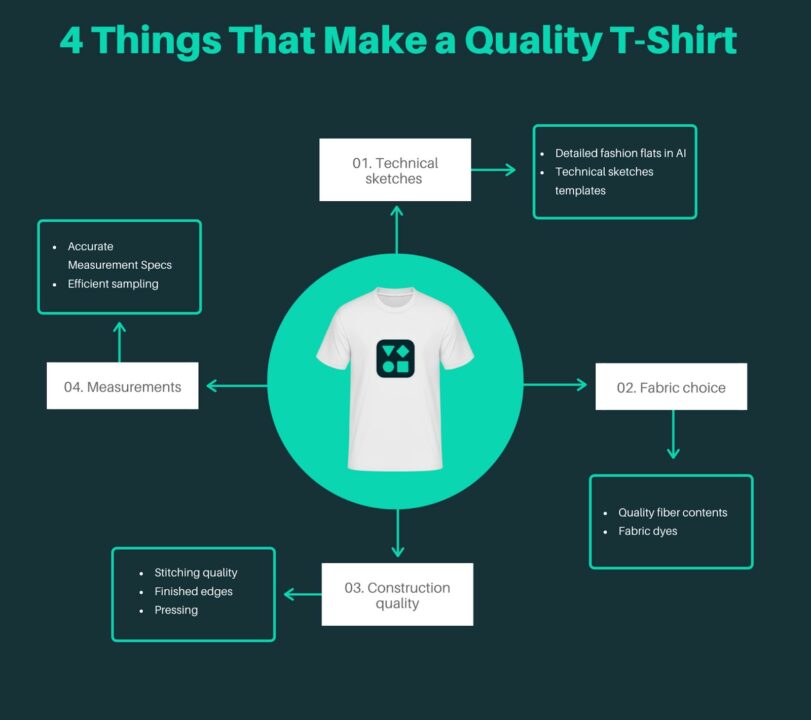
Designing eye-catching t-shirts
Creating visually appealing and unique designs, among others, guarantees a successful t-shirt business. Here’s how you can design them to perfection:
Incorporate trends and themes
Incorporate the latest trends and themes into your t-shirt designs. This can make them relevant and appealing. Updating your designs also helps you attract customers and stay ahead of the competition.
Here’s how:
- Research the market: Stay up-to-date with the latest fashion trends. Follow fashion blogs, magazines, and social media accounts to see what’s popular.
- Identify your niche: Determine what makes your business unique. Then, cater to the niche that your t-shirts appeal to. Create items that suit their style, theme, or target audience.
- Use color effectively: Use color to make your designs pop and stand out. Consider using bold and bright colors that are eye-catching and memorable.
Tools and software for design success
The right tools and software can help create professional, eye-catching, high-quality designs. Here are some key considerations:
- Graphic design software: Invest in powerful tools like Adobe Illustrator and Photoshop. These can help you come up with versatile and great-quality designs.
- Collaborative platforms: Use collaborative platforms such as Figma or Adobe Creative Cloud. They’re perfect for teamwork and design iteration when working with freelance designers.
- Mockup generators: Refine and perfect your creations using mockup generators. Tools such as Canva and Printful help you visualize how your designs will look on actual t-shirts.
Here’s an example from Printful’s generator.
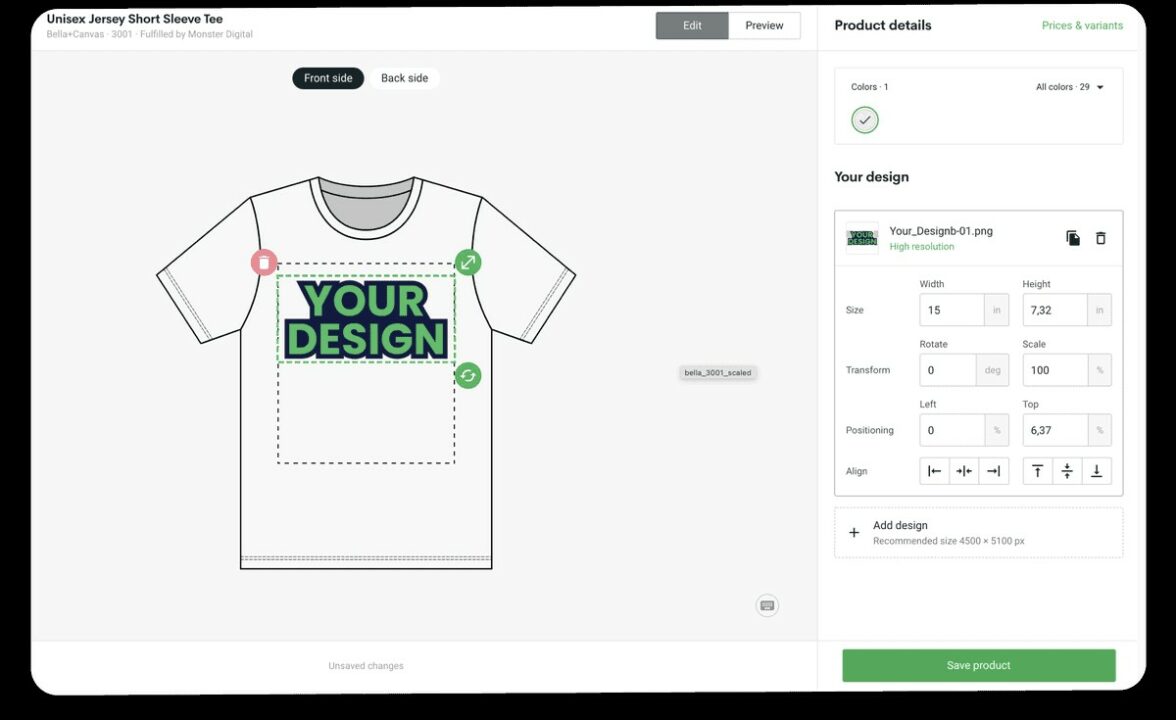
Sourcing high-quality materials and printing providers
Don’t underestimate the importance of high-quality materials and printing providers. Using high-quality materials helps your products look great, feel comfortable, and last long.
These tips will help you get an excellent start in the t-shirt printing business:
Select the right t-shirt fabrics
The fabric choice affects how a T-shirt fits, feels, and holds up in the wash. These factors impact customer satisfaction and, by extension, your company’s viability.
Consider the following:
- Fabric type: Cotton reigns supreme for its soft feel and breathability. However, a blend of cotton and other fabrics is ideal. They enable stretching, moisture-wicking, and wrinkle resistance.
- Sustainability: Sustainable fabrics are ethical and eco-friendly. They are more costly to source, and they appeal to environmentally conscious consumers.
- Weight and thickness: Your target market’s preferences determine the weight and thickness. Lighter fabrics are suitable for warm climates, while heavier fabrics provide warmth.
Evaluate printing techniques
Different printing techniques impart unique visual properties. So, test a few samples with various printers to reveal the best choice. Some options include:
- Screen printing: Involves pressing ink through a stencil onto the fabric. It’s ideal for large orders and designs with only a few colors.
- Direct-to-garment (DTG): Involves using a specialized printer to print the design directly onto the fabric. It’s ideal for small orders and designs with many colors.
- Heat transfer: Uses heat to print designs on paper before transferring them to the fabric. It’s perfect for small-scale operations and full-color designs.
Establish relationships with suppliers
Developing solid relationships with suppliers helps you access high-quality materials and printing services. These guidelines can help:
- Research and vet suppliers. Look for reviews, assess their production capabilities, and request samples.
- Negotiate terms. Discuss discounts, lead times, and minimum order quantities, but don’t compromise quality or service.
- Communicate regularly. Be clear about your requirements and expectations.
Building your online store
Building an online store is a crucial aspect of starting a t-shirt business. A polished, user-friendly ecommerce site establishes credibility and impacts conversion rates.
If you’re committed to selling t-shirts online, you must build an online store that stands out.
Choose the right ecommerce store
There are many ecommerce platforms, but not all are suitable for t-shirt businesses. You need to consider factors such as:
- The cost of hosting, maintenance, and transaction fees
- The ease of integration with your t-shirt design and printing tools
- The availability of features like inventory management, marketing tools, and analytics
- The scalability and security of the platform
Platforms such as Shopify and BigCommerce offer everything you need to sell online. They can help you create your store from scratch and manage your orders. They also provide ready-to-use templates.
Create an intuitive user experience
A user-friendly interface guarantees that your customers enjoy a positive shopping experience. Ensure that your business is user-friendly, allows effortless navigation, browsing, and purchasing. Here are some useful suggestions:
- Optimize your store for mobile devices
- Use clear and consistent branding
- Use descriptive and catchy product titles and descriptions
- Use high-quality images and videos to showcase your products
- Make it easier for customers to find what they need by using filters and categories
- Provide multiple payment options and secure checkout
- Use clear and visible call-to-action buttons
Creating an intuitive user experience doesn’t have to be complicated. You can get started by leveraging some of the best ecommerce tools available.
Marketing strategies for your t-shirt business
Promoting your brand online is necessary for sales success. A solid marketing plan helps you reach your target audience. It also showcases your unique designs and attracts potential customers.
Here are some ways to get started.
Implement email marketing
Email marketing enables t-shirt entrepreneurs to engage customers in an automated, cost-efficient manner. Here’s how to leverage ecommerce email marketing for your business:
- Build an email list: Encourage website visitors to subscribe to your newsletter. Offer exclusive deals or early access to new designs, and use popups and clear CTAs to prompt sign-ups. Segment your list for better targeting and personalization.
- Create engaging content: Craft compelling and visually appealing email content. You can showcase your latest designs, offer promotions, and share behind-the-scenes glimpses. This keeps subscribers interested and excited.
- Automate email campaigns: Use automation tools like Omnisend to send targeted emails. Use triggers like abandoned carts and prebuilt fashion newsletter templates to make sales.
Here’s how Omnisend’s abandoned cart workflow uses omnichannel messaging for targeting.
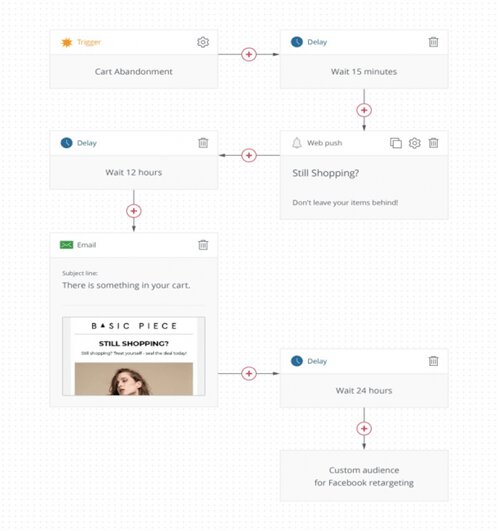
Promote your business on social media
Both organic sharing and paid ads on social media platforms like Instagram, Facebook, Pinterest, and TikTok drive awareness. Use them to:
- Post eye-catching photos and videos of your products
- Share user-generated content like customer reviews and testimonials
- Run contests and giveaways
Social media ads can also help target specific segments and increase conversions.
Collaborate with influencers
Working with influencers is an excellent ecommerce marketing strategy. It can help generate buzz around your business and amplify your brand’s reach. Here are some tips that can help:
- Identify influencers whose audience aligns with your target audience
- Allow influencers creative freedom to promote your t-shirts
- Gift your influencers free samples, commissions, or other incentives
- Measure and adjust the effectiveness of your influencer campaigns
Here’s how SARAL keeps track of influencer followers, reach, engagement rate, and more.
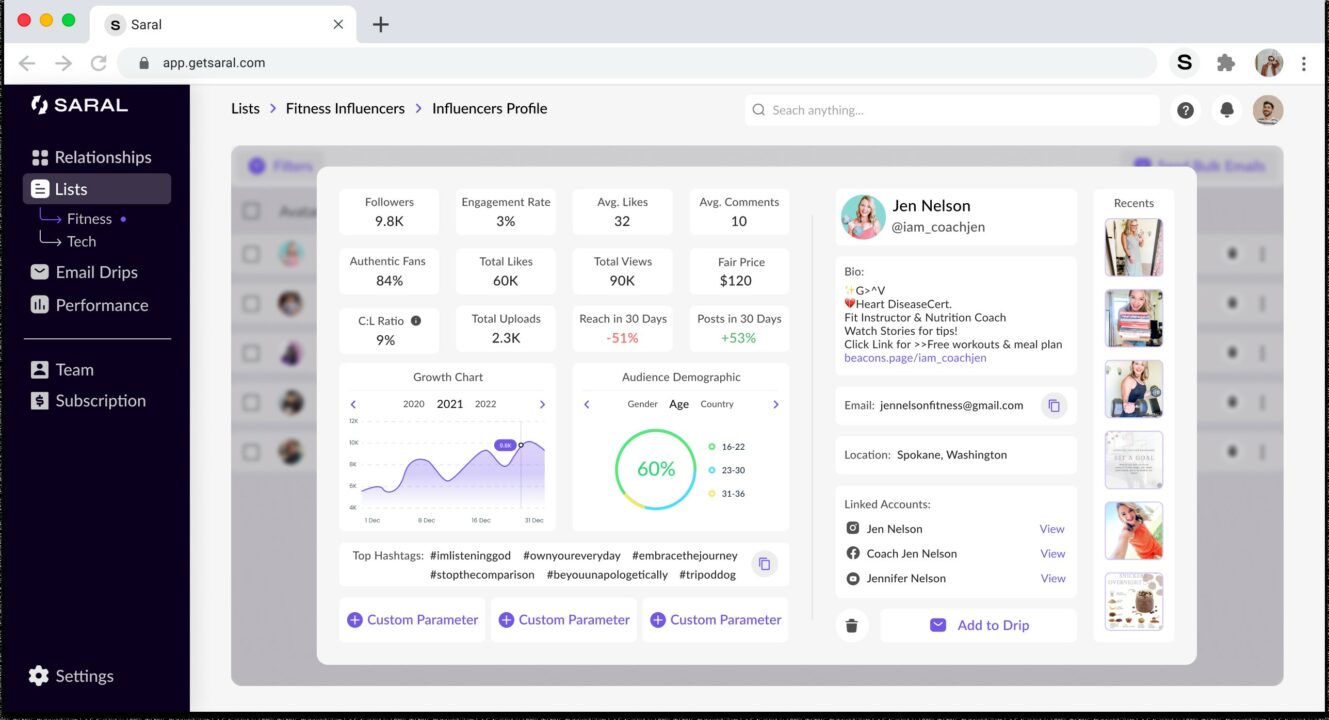
Analyzing performance and scaling your business
Scaling a t-shirt business requires analysis of key metrics and a solid growth plan. As you explore starting a t-shirt business, find effective ways to build and optimize for growth.
Key metrics for t-shirt businesses
Measure the success of your t-shirt business by tracking key metrics. Some of the most common metrics that reflect your performance are:
- Revenue
- Profit
- Cost per acquisition (CPA)
- Customer lifetime value (CLV)
- Conversion rate
- Return rate
- Customer satisfaction score (CSAT)
When and how to scale operations
First, you need to establish a loyal customer base and a profitable business model. You can use these clothing brand marketing ideas.
Next, scale your operations to reach new markets and increase your revenue. However, scaling too fast or slow can be risky for your t-shirt business.
When you have the following, you’re ready to scale:
- Consistent and growing demand for your t-shirts
- Positive cash flow and enough capital to invest in expansion
- Reliable and efficient supply chain and fulfillment process
- A solid and capable team that can handle the increased workload
- A clear vision and realistic growth plan
If you meet these criteria, you can consider scaling your operations by:
- Expanding your product range with new designs, styles, colors, and sizes
- Entering new markets with different demographics, geographies, and cultures
- Increasing your production capacity with more equipment, inventory, and staff
- Investing in ecommerce advertising to boost your brand awareness and traffic
- Diversifying your sales channels with online marketplaces and social media platforms
Wrap up
Design tools and global e-commerce have made starting a t-shirt business more accessible. However, identifying an underserved demographic is an excellent place to start.
You can also create trendy designs using quality materials and printing precision. This ensures the uniqueness of your brand.
Next, strategically market through email, social media, and influencers to amplify your visibility.
Lastly, let analytics guide your growth. Continually test new t-shirt business ideas to remain relevant as you scale.
quick links
related features
No fluff, no spam, no corporate filler. Just a friendly letter, twice a month.
